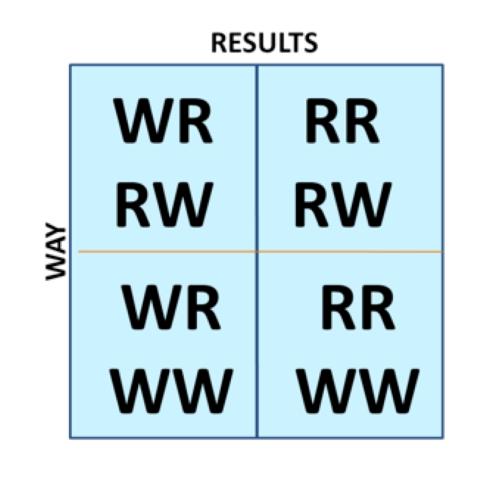As a front-line supervisor, your job was to deliver results. You were measured by and rewarded for performance. No matter what job function you were managing, your priority was to get the job done on time, under budget and in accordance with the quality standards set.
As you ascend the career ladder, you have increasingly greater degrees of responsibility for results. Once upon a time, your accountability as a crew foreman was to make sure the 6-8 members of your crew performed. That’s a far cry from your role and responsibility now as plant manager. Now you have 6-8 different function heads reporting to you, and each one manages a number of supervisors. Your responsibility for results is clear – the company’s senior executives and board members review the numbers produced by your plant and hold you accountable.
With the emphasis on results plus the accolades and rewards you’ve received for producing results, you may be singularly focused on the numbers, the volumes, the productivity, and the bottom line. That’s understandable. But it isn’t the only thing you need to be looking at.
As Senior Manager, you may not realize how profoundly your role has shifted. If you are just doing more of the same thing you did as a Supervisor, you are not going to succeed over the long term. If you are driving results and spending the majority of your time focused on making sure the team gets the right results, you are operating with a short-term perspective that will have long-term consequences.
In the role of Senior Manager, you need to make a shift to thinking about the “right way” as much as you think about the “right results.”
The right results are self-explanatory. You know what they are because they are clearly defined for you during budgeting, and you are reminded of them with each daily/weekly/ monthly/quarterly report you receive.
The right way, however, may be a bit ambiguous. That’s precisely why it requires your attention. You must define the right way, communicate what it is, set expectations around it and encourage those who abide by it. Right way means the way business is conducted. It includes business practices, demonstration of company values, how people treat one another in the workplace, and so much more.
The right way drives the right results. If you neglect to define and communicate the right way, you will eventually find yourself unable to produce the right results.
Use This Decision Model As A Way To Think About Your Job
Don’t let the results-oriented metrics get in the way of thinking equally about the right way. When you look at both dimensions as being equally weighted, you can evaluate the current condition. There are only four possibilities, and each one gives you direction about your next steps.

Obviously, the box you’d like for the company to be in is the one in the upper right hand corner. This is getting the Right Results the Right Way. The numbers look good. People are representing the company appropriately. You are building for the future and it not only shows on paper today, but will show in the future too because you are operating from a solid position.
Just as obvious is the lower left hand corner. This is the box you don’t want to be in. Ever. It’s getting the wrong results and doing business the wrong way. Corporate malfeasance has put many large companies into this box, and we’re all familiar with those scandals. On a smaller scale, companies find themselves in this box when they treat employees and/or customers poorly and this leads to an erosion of market share.
The other two boxes are where most senior managers end up at some point in their career.
You may be getting the right results but doing so in a wrong way. This happens, for example, when a sales team cuts rates and makes deals to get the top line revenue they’re accountable for. They get the right results. But the wrong way of doing so affects the bottom line and conditions buyers to hold out for a discount every time they do business with you. There’s a short-term gain (results) with a long-term pain.
Or you may be getting the wrong results but doing business in the right way. Perhaps you are not making the target number because you invested in production line enhancements to improve ergonomics for your employees. It was not anticipated, but you did it anyway. You chose what you considered to be the right way because you felt it would drive the right results over the long term. Safe and comfortable employees mean fewer worker’s comp claims and higher levels of productivity. Your values say you care about your employees, so you decided to act in alignment with those values.
Which approach have you taken in the past? What has been the cost or the benefit when you’ve prioritized right results? When you’ve prioritized right way? Which one do you think is more important and how does your belief guide your day-to-day decisions?
 Written by Deb Calvert, President, People First Productivity Solutions-Author of the DISCOVER Questions book series, Deb has worked as a sales productivity specialist and sales researcher since 2000. She is certified as a Master Sales Coach, Master Trainer, and host of CONNECT! an online radio show for selling professionals where listeners ignite their selling power in just an hour. Deb helps companies to boost productivity through people development. This work includes leadership program design and facilitation, strategic planning with executive teams, team effectiveness work, and performance management program design.
Written by Deb Calvert, President, People First Productivity Solutions-Author of the DISCOVER Questions book series, Deb has worked as a sales productivity specialist and sales researcher since 2000. She is certified as a Master Sales Coach, Master Trainer, and host of CONNECT! an online radio show for selling professionals where listeners ignite their selling power in just an hour. Deb helps companies to boost productivity through people development. This work includes leadership program design and facilitation, strategic planning with executive teams, team effectiveness work, and performance management program design.
Did you find this article informative? Let us keep you up-to-date on all of our training articles. Please sign up for our newsletter today!
Here are some related articles you may be interested in:
Emotional Intelligence in the Workplace: How to Develop Yourself & Your Team
Curiosity: Asking the Right Questions to Motivate, Manage & Lead
Strategic Leadership-How Strategic Are You?
How to Manage Team Conflict
Overcome Complacency in the Workplace
4 Essential Skills for Leaders, Managers & High Potentials
Business Strategy Assessment
ManagingAmericans.com provides Exclusive Management, Leadership & Cross-Functional Training in the form of articles, templates & webinars developed by Experienced Business Professionals & Expert Consultants sharing knowledge, success tips and solutions to common job issues. In addition to offering business assessments, and management consulting services, the site’s purpose is to mentor and develop professionals to be better leaders, managers, team players and individual contributors. Ultimately, helping people & businesses succeed via practical and actionable advice in a “do-it-yourself” environment.